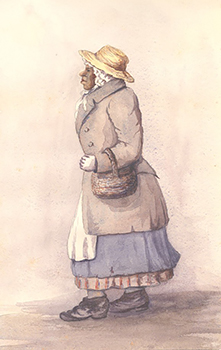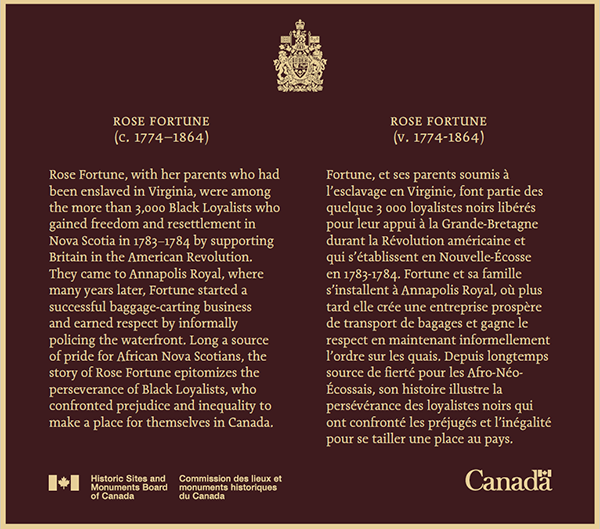Rose Fortune National Historic Person (circa 1774-1864)

© Nova Scotia Archives Documentary Art Collection: acc. no. 1979-147/56 | NSARM neg. N-6955 CN-9813
Rose Fortune was designated as a national historic person in 2017.
The Historic Sites and Monuments Board of Canada reviewed this designation in 2022.
Commemorative plaque: Plaza at corner of St. George and Church Street, Annapolis Royal, Nova ScotiaFootnote 1
Rose Fortune (ca. 1774–1864)
Rose Fortune, with her parents who had been enslaved in Virginia, were among the more than 3,000 Black Loyalists who gained freedom and resettlement in Nova Scotia in 1783–1784 by supporting Britain in the American Revolution. They came to Annapolis Royal, where many years later, Fortune started a successful baggage-carting business and earned respect by informally policing the waterfront. Long a source of pride for African Nova Scotians, the story of Rose Fortune epitomizes the perseverance of Black Loyalists, who confronted prejudice and inequality to make a place for themselves in Canada.
Rose Fortune

Rose Fortune’s life and accomplishments represent the struggle of Black Loyalists, including the unique challenges facing Black Loyalist women, in colonial Nova Scotia during the 18th century. One of more than 3,000 Black Loyalists who arrived in Nova Scotia in 1783-84, Fortune defied the barriers and prejudices of the time to become a respected and prominent member of the community. In Annapolis Royal, she was known for keeping peace and order on the waterfront where she worked for more than 20 years. Since the early 20th century, Fortune’s story has become a source of ongoing pride for African Nova Scotians. Her life represents the endurance and survival of Black Loyalists, who confronted prejudice and inequality to make a place for themselves in Canada.
Fortune was born c. 1774 in the British colonies that became the United States. Her family earned their freedom from slavery and resettled in Nova Scotia through their support of the British during the American Revolution. They travelled from New York as part of the 30,000 Loyalists evacuated to Nova Scotia at war’s end, settling in Annapolis Royal. As an adult, Rose Fortune became a figure of renown both locally and throughout Nova Scotia for her baggage-carting business along the waterfront and for acting as the unofficial town “police officer,” well before the existence of a professional police force. Travellers passing through Annapolis Royal, military officers, and officials wrote of their encounters with her. They described her carrying bags and rousing her clients to catch their boats. Residents of Annapolis Royal remembered her with great affection as an iconic representative of their town and a determined keeper of order on the streets. She was the subject of an anonymous watercolour from the 1830s, one of only two contemporary images of Black Loyalists. In the 1920s, a Montréal journalist, inspired by the portrait, researched her life and impact on Annapolis Royal, gathering living memories of Fortune that illustrate the power of her character and the impact she had in her lifetime. Her descendants have also preserved and re-told her story.
Very few complete life stories of Black Loyalists have survived, making Rose Fortune’s one of great historical value. Most accounts of this era record moments of transition or brief narratives of struggle, providing only fragmented insights into the lives and the achievements of Black Loyalists in Canadian history. Rose Fortune’s story tells of a Black Loyalist life from childhood migration through a life of community activity, to her legacy in Nova Scotia and the African-Canadian community.
Backgrounder last update: 2023-10-12
Review of designation
Reviews are undertaken on an ongoing basis to ensure that designations reflect current scholarship, shifts in historical understandings, and a range of voices, perspectives and experiences in Canadian society.
In 2022, this designation was reviewed due to errors in the commemorative plaque text. Two issues were identified in Fortune’s biographical information. The original plaque text stated Fortune had siblings and was born into slavery. New research shows these details of her life are uncertain.
As it is not known for certain whether Fortune was born into slavery, the plaque text was modified to include that her parents were once enslaved. The mention to having siblings was also removed. A new plaque was installed in 2022.
Source: Historic Sites and Monuments Board of Canada, Minutes, February 2022.
The National Program of Historical Commemoration relies on the participation of Canadians in the identification of places, events and persons of national historic significance. Any member of the public can nominate a topic for consideration by the Historic Sites and Monuments Board of Canada.
- Date modified :